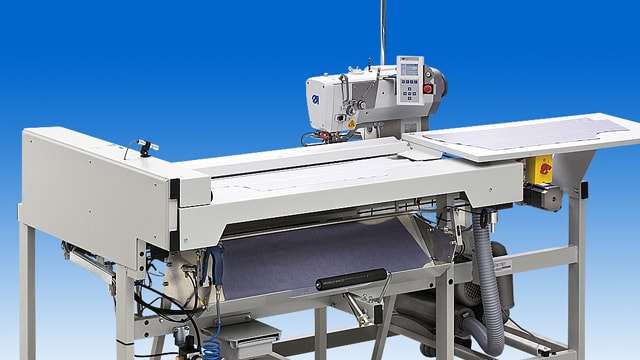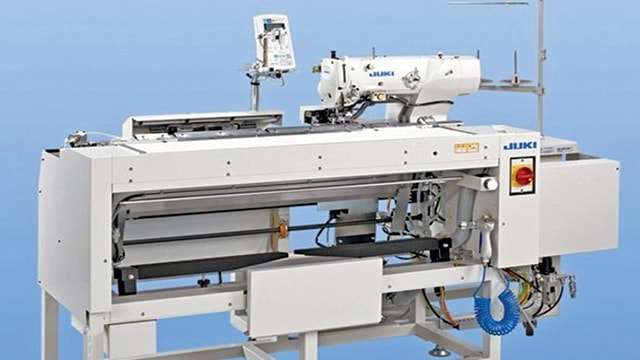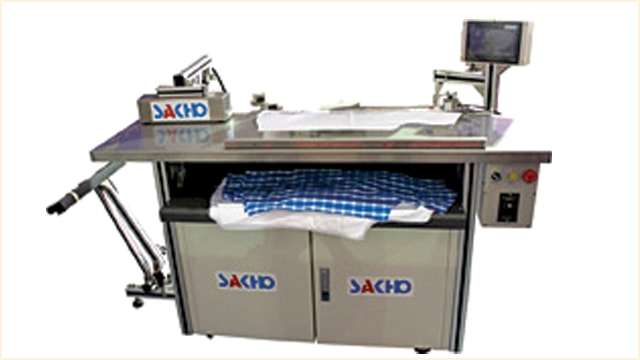
The Brother BAS series of button sewing and buttonholing indexers were introduced as early as the nineties, but probably timing was too premature for the Asian manufacturers to adopt the technology. In recent times, Juki, Zoje, Sakho, Yuho and Duerkopp Adler have launched button sewing and buttonholing indexers for men’s shirts, ladies blouses, etc. These automatic machines carry various advantages over conventional buttonholing and button making machines like reduction of manufacturing time due to reduced sewing cycle time, reduction of defects due to increased accuracy and reduction of helpers which were previously required for mark positioning of buttons and buttonholes.
The positioning accuracy achieved by machine cannot be matched manually. Operating time is also considerably reduced because it is almost as good as an automatic robot doing the work by itself and there is lesser waiting time since one operator can operate two to three machines simultaneously. The automation in sewing is increased up to 50% as the operator doesn’t have to align the garment panel repeatedly or mark the panel for stitching. Nowadays manufacturers prefer lockstitch buttonholing and button sewing indexers over chainstitch ones because of demand for more seam security in garments by the buyers.

Technology behind buttonholing and button sewing indexers
A typical button indexer unit is equipped with a sewing head, direct drive motor, preset board, and three sub-clamp catch plates and in some machines with a long holder called carriage, they are equipped with cloth plate, adjuster gauge, carriage and a stacker to dispose sewn shirt front. Below stated are the advantages of distinguishing features present in various machines which result in enhanced productivity, efficiency and quality of the machine.
• Available in the indexers from Duerkopp Adler and Juki, the preset mechanism allows the operator to place the subsequent garment piece on the preset board while the sewing machine is still engaged in the sewing of the current garment piece. Consequently, the operators can now use their waiting time effectively during operation to achieve increased productivity.
• Sub Clamp Device automatically brings the subsequent shirt front panel to the sewing position after the buttonholing of the current panel to allow the sewing machine to immediately start the next buttonholing. This function works effectively, especially in cases where the operator is operating two or more sewing machines or is carrying out other work simultaneously. The device is available in button indexers from Duerkopp Adler and Juki.
• Cloth Edge Sensor is a device for detecting the material edge (the collar side). Even if the operator fails to correctly position the material on the sewing machine, the cloth edge sensor detects the material edge (the collar side) to keep the distance from the upper edge of the material to the first buttonhole at a preset distance. This feature is used in combination with the Conveyor Belt System for smoothly moving the fabric in the direction of the sewing head, like in case of the buttonhole indexers from GTN and Juki, the apparatus avoids any kind of fabric damage.

• Automatic Vacuum System is used for fixing the position of the shirt front panels while sewing, which ensures that no buttonhole is positioned inappropriately. Present in buttonholing indexers of Duerkopp Adler and button sewing indexers of Yuho, it helps in improving the finished product quality and productivity by further deskilling the operation. In addition to all the above features, the button sewing indexers have a button feeder attachment and movable adjuster at one end to slide the fabric according to button placements and button detection system for automatically calculating the distances of each button and buttonhole from the top button position. Apart from this, stitch length and stitch density regulation, point to point stitching and firm material holding add up to the functionality of these machines.
Method of working: Buttonholing and button sewing indexers
Amongst the button sewing and buttonholing indexers, GTN and Zoje score above other manufacturers in terms of productivity and cycle time, hence can be used by manufacturers handling large quantities.
In case of buttonholing indexers, the operator is only required to place the shirt front panel parallel to the adjuster clamp, which fixes the neckline of front panel with the help of two sub-clamp catch plates. Similarly, the bottom edge of the front panel is fixed and aligned via the same mechanism. After the placement is complete, the sewing head automatically stitches the buttonholes at preset positions with the help of belt conveyor fixed in the machine which keeps on feeding the fabric and making buttonholes adjusting the distance on the front placket of the shirt. After the buttonholes have been sewn, the shirt front slips towards the back of the machine with the help of the third sub clamp catch plate and an automatic stacker comes from the back of the machine to catch the piece over it and place it on a stand. This synchronization of the adjuster clamp, belt conveyor and stacker is made possible with the help of the touch screen control panel, in which the parameters of stitch density, stitch length, buttonhole length and fixing distance between buttonholes are defined before commencing operations of the machine. All the above automations work exactly in the same manner in case of button sewing indexers, except that the buttons are fed by a button feeder which keeps delivering buttons to the sub clamp for placement of the sewing head.
Benefits of installing buttonholing indexers
Buttonholing indexers not only carry advantages like automatically and accurately sewing buttonhole in lockstitch mode but also have improved cycle time for sewing a buttonhole according to a recent time study done on different types of buttonhole indexers and ordinary buttonhole making machines. Various findings came out in this study regarding sewing cycle time which have been presented in Table 1.1.
|
Table 1.1 Total cycle time of different buttonhole indexers along with ordinary buttonholing cycle time |
|
Serial No. |
Machine Type |
Machine Model |
Pick the piece (in secs) |
Buttonholing (in secs) |
Dispose (in secs) |
Total Time (in secs) |
Actual Time per buttonhole (in secs) |
|
1 |
GTN |
GTN1054BHVJ |
17 |
21 (for 6) |
3 |
41 |
6.83 |
|
2 |
Duerkopp Adler buttonhole Indexer |
Class 841 |
9 |
32 (for 7) |
2 |
43 |
6.14 |
|
3 |
Zoje |
ZJ-ACF-S-5780 |
5 |
9(for 3) |
1 |
15 |
5 |
|
4 |
Juki |
AC-172N-1790 |
4 |
20(for 5) |
3 |
27 |
5.4 |
|
5 |
Sakho |
SA-5800 BH |
6 |
26(for 6) |
5 |
37 |
6.16 |
|
Ordinary button- holing machine |
540-100 |
4 |
36 (for 5 with manual positioning) |
4 |
44 |
8.8 |
Table 1.1 Total cycle time of different buttonhole indexers along with ordinary buttonholing cycle time
On the basis of the total cycle time values from pick to dispose which emerged for various buttonholing indexers, it was found out that there has been improvement in actual sewing time that is needle down time resulting in increase in average production. The percentage improvements have been summed up in Table 1.2.
|
Table 1.2 Improvement in buttonhole indexers with respect to ordinary button holing machine in percentage in respect of actual sewing time, total cycle time, average production per hour and shirt completed per hour |
|
Serial No. |
Machine Type |
Serial No. |
%improvement in actual sewing time |
% improvement in total cycle time |
Average Production per hr in terms of no. of button holes made |
Shirts completed/hr with 6 button holes |
|
1 |
GTN |
GTN1054BHVJ |
51.3% |
22.3% |
458 |
76 |
|
2 |
Duerkopp Adler buttonhole Indexer |
Class 841 |
36.5% |
30.1% |
509 |
85 |
|
3 |
Zoje |
ZJ-ACF-S-5780 |
58.33% |
43.1% |
626 |
104 |
|
4 |
Juki |
AC-172N-1790 |
44.44% |
38.63% |
579 |
96 |
|
5 |
Sakho |
SA-5800 BH |
39.81% |
29.92% |
507 |
84 |
Table 1.2 Improvement in buttonhole indexers with respect to ordinary button holing machine in percentage in respect of actual sewing time, total cycle time, average production per hour and shirt completed per hour
Benefits of installing button sewing indexers
Apart from the benefits that buttons need not be placed by operator again and again for sewing, there has been cycle time improvement too which has been illustrated in Table 1.3.
|
Table 1.3 Total cycle time of different button sewing indexers along with ordinary button sewing cycle time |
|
Serial No. |
Machine Type |
Machine Model |
Pick the piece (in seconds) |
Dispose (in seconds) |
Buttonholing (in seconds) |
Total Time (in seconds) |
Actual Time per buttonhole (in seconds) |
|
1 |
Yuho |
U-2607-LK |
4 |
17 (for 5) |
5 |
26 |
5.2 |
|
2 |
GTN |
GTN-1054BSB |
6 |
11 (for 6) |
4 |
21 |
3.5 |
|
3 |
Sakho |
SA5800 BS |
8 |
14 (for 6) |
3 |
25 |
4.16 |
|
Ordinary button sewing machine |
MB-372 |
2 |
30 (for 6 with manual positioning) |
5 |
37 |
6.16 |
Table 1.3 Total cycle time of different button sewing indexers along with ordinary button sewing cycle time
On the basis of the total cycle time, values from pick to dispose which emerged for various button sewing indexers, it was found out that there has been improvement in actual sewing time that is needle down time resulting in increase in average production. The percentage improvements have been summed up in Table 1.4.
|
Table 1.4 Improvement in button sewing indexers with respect to ordinary button sewing machine in percentage in respect of actual sewing time, total cycle time, average production per hour and shirt completed per hour |
|
Serial No. |
Machine Type |
Model |
%improvement in actual sewing time |
% improvement in total cycle time |
Average Production per hour in terms of buttons stitched |
Shirts completed per hour with 6 button placements |
|
1 |
Yuho Button indexer |
U-2607-LK |
32% |
15.6% |
602 |
100 |
|
2 |
GTN button indexer |
GTN-1054BSB |
63.4% |
43.2% |
894 |
149 |
|
3 |
Sakho button indexer |
SA-5800-BS |
53.33% |
32.43% |
751 |
125 |
Table 1.4 Improvement in button sewing indexers with respect to ordinary button sewing machine in percentage in respect of actual sewing time, total cycle time, average production per hour and shirt completed per hour
As one operator can operate more than one machine simultaneously, specialized shirt manufacturing companies can really drive value out of these indexers with increase in productivity per operator. The laser light ensures no chalk marking resulting in time saving during spotting and support clamp ensures pieces are arranged neatly, effectively saving time for the next operation. Ordinary process of buttoning and holing, once the shirt sewing is complete, incurs more handling time; use of indexers will change the process flow to buttoning and holing being done before the shirt assembly, thus reducing crucial handling time.
Conclusion
When buying a buttonhole or button sewing indexer, essential features which should be looked for are cost of the machine, service offered by the sewing machine providers, preset mechanism for reducing operating time, stacker to carry the stitched pieces to reduce dispose time, and last but not the least, the speed of the machine. The ability to handle diverse varieties of buttonholes as well as button sewing designs also plays a significant role since the automat should be able to sew different style variations without much modification of the machine.

Post a Comment